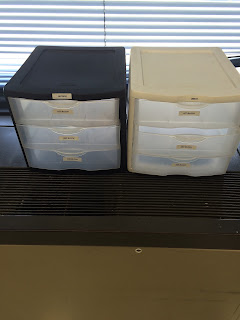Hey guys!
It's hard to believe that another school year is upon us. Summer went by way too fast! One of my favorite parts of another school year starting is that I get to go in and decorate my classroom. Let me tell you about the process.
Our school was really fortunate to get new student tables and chairs, so goodbye desks! Also, our school is getting Chromebooks and is (finally) going 1:1.
Before I did anything, I took the calculators out of their case, labeled them, and put them in my organizer. I bought a shoe organizer from Walmart, and I wrote 1 through 24 to label them. Then I borrowed my girlfriend's label maker and labeled them with my initials 1-24 to organize. I have used this system for two years, and it works like a charm. I can see what calculators are missing very quickly!
I then hung my poster that my girlfriend's sister in New Mexico made for me. She is a graphic designer, and I think she did an awesome job on this. These (of course) are my guidelines and consequences. I hang this in a visible place in the front of the classroom.
I bought this banner at Target for $3. I thought it was neat, but I had no idea what to do with it. My girlfriend and I proposed putting a saying on it. She (being the genius she is) came up with "Math Rules" and we went with it. I don't draw at all (even though I'm a geometry teacher). So, she did all of that as well.
My friend, coworker, and neighbor across the hall, Samantha, made this sign for me to hang on my door knob. It's neat as well!
My girlfriend's mom, who lives in St. Thomas, bought me this poster. It's a poster of a painting of Charlotte Amalie Harbor. I hung it in my classroom. The small sign was a gift from my girlfriend at Christmas. The C-Bulldogs is a school thing. Go Dogs!
I got the idea of the poster from a Twitter conversation from several months ago. So, I made it on Google Slides, saved it as a PDF, and took it to Staples to have it made into a poster.
I bought the sign at Hobby Lobby for a couple of dollars and used Command Strips to hang it.
For the bulletin board, I got several inspirations. The first part, "Solve It!" came from
Sarah Carter's blog. I was trying to think of a way to make this work as a bulletin board and do something different from last year. So I came up with Solve It! as a way to encourage problem solving strategies. The "Group Work Roles" inspiration came from Jo Boaler's new book, Mathematical Mindsets. I really liked the way that she did her group roles in the book, so I decided to make signs for this. The third part also came from her book, but I got the quotes from Sarah Carter and from MashUp Math's new E-book. For those, I made Google Slides and printed them off to put on the bulletin board.



You gotta have systems to run your classroom! The clipboards are my sign-in/out sheet and my tardy sheet. This way I have documentation for when students are out of the classroom and tardy to class. The second picture is of my recycling bins. I want to encourage students to recycle, especially since I try to recycle myself. It's a good habit to get into, and it's great for the Earth!
I made two signs from the resources from the TMC16 presentation "Talk Less, Smile More", and they talk about claims and warrants being the two parts of a mathematical argument.
The next part I got from
here. I wanted to incorporate the Mathematical Practices in my classroom and have them in a visible area. I also wanted them to be in student-friendly terms. I took the resources from the link, and I made a Google Slide presentation. I then printed it off and displayed at the front of my classroom.
I got these quotes from a display at the school where my girlfriend's mom works. I then took the quotes, and, you guessed it, made Google Slides, and printed them off. I placed them at the whiteboard at the back of my room.
Then I had to organize my supplies. I bought containers at the Dollar Tree and labeled them. For the inbox and outbox, I just used drawers I had from the past, and I labeled them by block. Then I bought a crate at Walmart to put in my whiteboards. Then I used a plastic shoe container to put the markers. I bought "erasers" by buying some washcloths at Kmart, and my girlfriend cut them up into smaller pieces.
I bought the TEACH and LEARN signs at Target for $3 each! I think they are a great addition.
Now I will leave you with some pics of the room all the way around it! Enjoy!

































